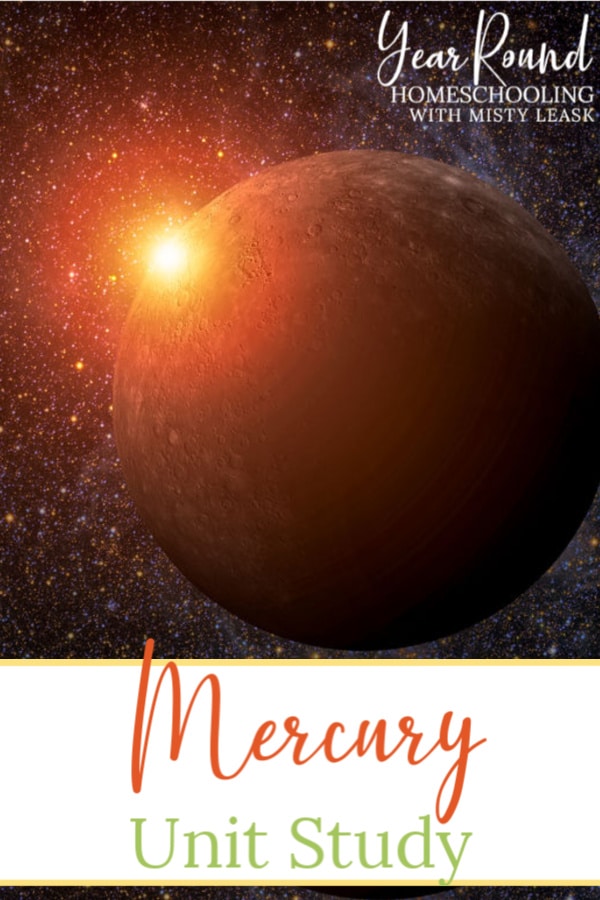I love sunrises too much to even consider living on Mercury if it were possible. Your kids will enjoy learning about Mercury sunrises, its speed, layers and more using this Planet Mercury Unit Study.

The solar system is a great way to study science in your homeschool. Spending time together with your kids studying the planets, their moons and view them in the night sky make amazing memories.
Mercury may be small, but there is a lot to learn about this “little” planet. Enjoy learning new things with your children as you complete this unit study together.
Planet Mercury Unit Study
Mercury
Did you know? Mercury has the shortest year, the smallest axis tilt and has the most craters? It also is the fastest planet though it spins slowly!
It was first explored in 1974 by NASA’s spacecraft, Mariner 10. They later completed the first orbit around Mercury using their spacecraft, Messenger, in 2008.
While on Earth we see the sunrise every single day, if you lived on Mercury, you would only see the sunrise every 180 days!
Mercury is a terrestrial planet, like Earth. However, it is only 1/3 the size of our home planet.
- Name
The planet Mercury was named after the messenger god of the Romans.
- Size
Mercury is the smallest planet in our solar system.
-
- Radius
The radius of Mercury is 1,516 miles. You can easily figure out the radius of any planet on your own by using the distance from the center to the edge of the planet.
-
- Diameter
Mercury’s diameter is an average of 3,031.67 miles. Finding the diameter of a planet is easy once you know its radius. Simply take the radius and multiply it times two.
-
- Mass
The mass of Mercury is 330,000,000 trillion metric tons, making it the least massive planet in our solar system.
-
- Volume
Mercury’s volume is 14,593,223,446 miles3. Do you know how to measure volume? You’ll need this mathematical formula, V = 4/3 pi x r^3, and the radius of the planet. The measure of volume determines how much space a three-dimensional object such as a planet occupies.
-
- Surface area
The surface area of Mercury is 28,879,000 square miles. Finding the surface area requires you to determine what number of square units will exactly cover the surface of a sphere. You’ll need this formula to determine Mercury’s surface area, (or any sphere) on your own.
-
- Density
At 5.427 g/cm3, the planet Mercury is the 2nd most dense planet in our solar system.
- Location in the Solar System
Mercury is the closest planet to the Sun.
- Distance from the Sun
All planets in the solar system are always moving, but on average Mercury is 32,983,125 miles from the Sun.
- Light time from the Sun
It only takes light from the Sun 3.03 minutes to reach Mercury.
- Layers
Mercury has 3 layers; the core, a mantle and a crust. The core is 1,289 in radius and is made of metal. The outer shell is made of the mantle and crust and is approximately 250 miles thick.
- Temperature
The temperature on Mercury is very extreme with ranges from -290 degrees Fahrenheit up to 800 degrees Fahrenheit due to its lack of an atmosphere to help retain the heat.
- Speed
Mercury travels at the average speed of 105,946 mph. That means in one 24 hour day on Earth, Mercury travels about 2,542,704 miles!
- Orbit
It takes less than 3 months, 88 days on Earth, for Mercury to travel around the Sun. Mercury travels through its orbit at approximately 29 miles per second.
- Axis Rotation
Mercury spins slowly on its axis, so a complete axis rotation or day on Mercury is equal to 59 Earth days.
- Exosphere
Since Mercury is so close to the Sun, it doesn’t really have an atmosphere, instead, it has an exosphere. Mercury’s exosphere is made up of oxygen, sodium, hydrogen, helium and potassium.
Please note, that some of the resources below may include evolutionary information. I encourage you to have a conversation with your children or preview these resources prior to assigning them as part of your homeschool studies.
Articles
Mercury: The Tiny Planet Causing Big Problems for Evolution
Literature
 MercuryShop on Amazon
MercuryShop on Amazon Are We There Yet? All About...Shop on Amazon
Are We There Yet? All About...Shop on Amazon Planet Mercury (A True Book...Shop on Amazon
Planet Mercury (A True Book...Shop on Amazon How Hot is Mercury? | Space...Shop on Amazon
How Hot is Mercury? | Space...Shop on Amazon 14 Fun Facts About Mercury:...Shop on Amazon
14 Fun Facts About Mercury:...Shop on Amazon Mercury: The Iron Planet (O...Shop on Amazon
Mercury: The Iron Planet (O...Shop on Amazon Thank You Mercury! (Kid Ast...Shop on Amazon
Thank You Mercury! (Kid Ast...Shop on Amazon Mercury (Planets in Our Sol...Shop on Amazon
Mercury (Planets in Our Sol...Shop on Amazon
Videos
Art
Mercury Art Poster
Activities
Printables
Fill in the Blank Mercury Facts
Mercury is an amazing little planet and its size doesn’t keep it from amazing us. The wonder of this planet and the rest of the solar system truly point to the majesty of God.
What did your kids enjoy learning the most through your Planet Mercury unit study?

